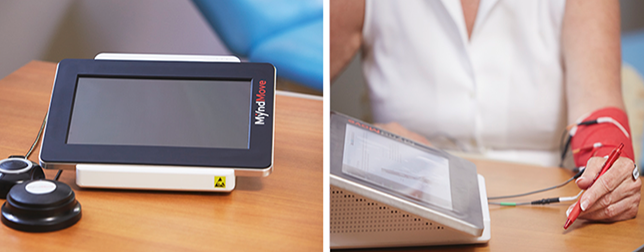Researchers in Canada have created an electrical assistive device called MyndMove that helps people with paralysis move on their own.
Anita Keyzer became a quadriplegic after a crash in 1996.
“The doctor came up to me and he literally just told me point blank, ‘You broke your neck and you’re never going to walk again,’” said Anita Keyzer.
Howard Rocket was injured after falling on his neck while playing touch football back in 1995. “I hit my head, the back of my neck and I had a Basilar stroke about three weeks later. My entire life changed,” said Rocket, “I couldn’t speak, I couldn’t see, I couldn’t move.”
Read more Kessler Foundation and Virtualwear Team Up to Improve Recovery Outcomes in Stroke Patients
Anita Kaiser and Howard Rocket shared their stories in a documentary made by Bonnie Brown called “The Mind Moves in Mysterious Ways.” The documentary looks at MyndMove, the device invented by Canadian scientists that’s helping paralyzed Canadians regain movement in their limbs.
About half a million people in Canada are affected by paralysis caused by spinal cord injury or stroke.
Until recently, those people had been told to assume there was virtually no hope of regaining the movement they’d lost.
But that all changed, in part because of a stunning scientific breakthrough made by Dr. Milos Popovic, a Senior Scientist and Research Director of the Toronto Rehabilitation Institute, and his team of biomedical researchers.

A little over 15 years ago, the scientists were trying out MyndMove, an electrical assistive device designed to stimulate paralyzed limbs when suddenly they discovered that their test subjects could suddenly move again – on their own. The device actually healed their brains and nerves.
It was one of the most dramatic examples of what’s now known as neuroplasticity. Neuroplasticity is the ability of the brain to change throughout an individual’s life, e.g., brain activity associated with a given function can be transferred to a different location, the proportion of grey matter can change, and synapses may strengthen or weaken over time.
Read more Myosuit: Wearable Device that Helps Myopathy or Stroke Patients Walk
MyndMove uses a technique known as non-invasive functional electrical stimulation (FES), which utilizes low energy electrical pulses to artificially generate body movements in individuals who have been paralyzed due to injury to the central nervous system. It was approved for use in Canada in 2014, and has already helped hundreds of people.
It’s only available in a few clinics and hospitals. Patients must be able to travel to get the therapy and pay for it. Insurance companies will cover the cost, but so far, provincial health plans do not.
The scientists at the Toronto Rehabilitation Institute is hoping to make another leap forward. In collaboration with Myant, a textile computing company in Mississauga, they’re working on a wearable version of the device that could put MyndMove into the hands and homes, of millions of patients all over the globe.












